|
|
|
Sort Order |
|
|
|
Items / Page
|
|
|
|
|
|
|
| Srl | Item |
| 1 |
ID:
106235
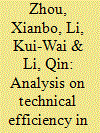

|
|
|
|
|
| Publication |
2011.
|
| Summary/Abstract |
This paper employs a fully nonparametric stochastic frontier model with time and individual effects to study technical efficiency in China's post-reform economy. The panel data cover China's thirty provinces for the period of 1985-2008. The empirical results show that the average output elasticity of labor is larger than the other two inputs of capital and human capital. Based on the specified inefficiency Tobit model, the factor analysis on technical efficiency shows that the time effects of technical efficiency in China's post-reform economy are significantly contingent on the factors. There exists significant regional differences in technical efficiency in China's economic development, and a number of policy implications can be drawn.
|
|
|
|
|
|
|
|
|
|
|
|
|
|
|
|
| 2 |
ID:
091696
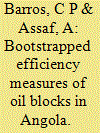

|
|
|
|
|
| Publication |
2009.
|
| Summary/Abstract |
This paper investigates the technical efficiency of Angola oil blocks over the period 2002-2007. A double bootstrap data envelopment analysis (DEA) model is adopted composed in the first stage of a DEA-variable returns to scale (VRS) model and then followed in the second stage by a bootstrapped truncated regression. Results showed that on average, the technical efficiency has fluctuated over the period of study, but deep and ultradeep oil blocks have generally maintained a consistent efficiency level. Policy implications are derived.
|
|
|
|
|
|
|
|
|
|
|
|
|
|
|
|
| 3 |
ID:
092738
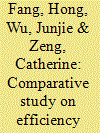

|
|
|
|
|
| Publication |
2009.
|
| Summary/Abstract |
Continually rising energy prices in global markets highlights a serious concern about the need to improve energy efficiency and the efficiency in energy sector in many countries. China, as one of the fastest growing countries in the world and the largest coal producer, has high coal consumption but a low recovery rate of coal utilization. Coal efficiency and the efficiency in coal industry have therefore attracted a great deal of attention from Chinese policy makers, coal firms and academics. This study attempts to compare the relative technical efficiency performance of listed coal mining companies in China and the US using CCR and BCC models in the advanced DEA linear programming. The results show that the level of relative efficiency in Chinese coal mining enterprises, regardless of total technical efficiency or decomposed pure technical and scale efficiency, is much lower than in American coal firms. The study also highlights the input resources that cause the inefficiency of Chinese coal mining companies. Furthermore, in-depth discussion and analysis of how the institutional environments of the two countries could cause the differences are provided.
|
|
|
|
|
|
|
|
|
|
|
|
|
|
|
|
| 4 |
ID:
125733
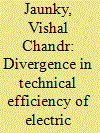

|
|
|
|
|
| Publication |
2013.
|
| Summary/Abstract |
This paper investigates the convergence pattern of technical efficiency of the South Africa Power Pool (SAPP) utilities over the period April 2003-March 2010 by means of parametric and non-parametric techniques. Technical efficiency scores are computed via both stochastic frontier analysis and data envelopment analysis. Mixed results are obtained from the neoclassical convergence approaches. In addition, distribution dynamics methods reveal some evidence of club-formation and this result is supported with the occurrence of ?-divergence. Taken as a whole, technical efficiency is found to diverge among the utilities operating in the power pool.
|
|
|
|
|
|
|
|
|
|
|
|
|
|
|
|
| 5 |
ID:
125456
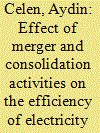

|
|
|
|
|
| Publication |
2013.
|
| Summary/Abstract |
In this study, we analyze the efficiency performances of Turkish electricity distribution companies throughout 2002 and 2009 in the stochastic frontier analysis (SFA) framework. Our more specific goal is to measure how the efficiency performances of the electricity distribution regions were affected by the mergers between distribution regions occurred in 2005. The results demonstrate that efficiencies of the companies serving to mostly the residential customers are higher than those of other companies. However, the positive impact of residential customers on the efficiencies decreased significantly following the mergers between electricity distribution companies. In contrast, the positive impact of higher customer density on efficiency also decreased, but insignificantly following the restructuring activities in the market in 2005. Our study also witnesses that the positive impact of the mergers on the efficiencies decreases as the proportion of sales to residential customers in regions increases. In contrast, the restructuring activities of 2005 increased equally the efficiencies of the companies serving in the regions with higher and lower customer densities.
|
|
|
|
|
|
|
|
|
|
|
|
|
|
|
|
| 6 |
ID:
089553
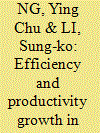

|
|
|
|
|
| Publication |
2009.
|
| Summary/Abstract |
The social science research performance of Chinese universities is examined using panel data. The universities are found to be very inefficient in general, with not much difference between regions. By far the largest single cause of universities? overall technical efficiency is pure technical efficiency, along with a considerable amount of scale inefficiency and a modest amount of congestion. No obvious regional differences in the universities? productivity growth are apparent between 1998 and 2002. Decomposition of the Malmquist productivity index indicates that although there has been technological progress over the years, poor scale efficiency and technical efficiency have resulted in deterioration in the universities? average productivity. There are signs of increasing congestion during the period studied.
|
|
|
|
|
|
|
|
|
|
|
|
|
|
|
|
| 7 |
ID:
159805


|
|
|
|
|
| Summary/Abstract |
The study estimates the technical efficiency (TE) of agricultural production in India using production frontier model for both cross-section and panel data for the years 1999 and 2007. Given the persistent low productivity of agriculture in India, there is a serious need to identify the determining factors for technological lock-in for agricultural production in order to accelerate sustainable productivity and technical efficiency. The model claims that farmer’s education, household’s production process, proportion of irrigated area covered by canals, availability of wells, yielding variety of lands, government services, agricultural expenditure by local government and women reservations in local government significantly contribute to efficiency in resource utilization in farm production. Traditional techniques such as ‘learning by doing’ is, generally, preferred than the adoption of new technologies for agricultural production. It makes a constraint of technological lock-in.
|
|
|
|
|
|
|
|
|
|
|
|
|
|
|
|
| 8 |
ID:
095937
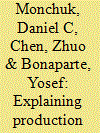

|
|
|
|
|
| Publication |
2010.
|
| Summary/Abstract |
In this paper we examine more closely the factors associated with production inefficiency in China's agriculture. The approach we take involves a two-stage process where output efficiency scores are first estimated using data envelopment analysis, and then in the second stage, variation in the resulting efficiency scores is explained using a truncated regression model with inference based on a semi-parametric bootstrap routine. Among the results we find that a heavy industrial presence is associated with reduced agricultural production efficiency and may be an indication that externalities from the industrial process, such as air and ground water pollution, affect agricultural production. We also find evidence that counties with a large percentage of the rural labor force engaged in agriculture tend to be less efficient, and suggests that nurturing and promoting growth of non-primary agriculture may lead to more efficient use of labor resources in agriculture.
|
|
|
|
|
|
|
|
|
|
|
|
|
|
|
|
| 9 |
ID:
089550


|
|
|
|
|
| Publication |
2009.
|
| Summary/Abstract |
In this paper we fit stochastic frontier production functions to data of Chinese farms grouped into each of four regions-North, Northeast, East, and Southwest-over 1995-1999. These frontier production functions are shown to have statistically different structures, and the elasticities provide some evidence of diminished marginal products of chemical inputs in the East and capital services in the North and Southwest. Labor has a low elasticity except in the North. Standardized technical efficiency scores are estimated for the farms and are shown to have the same structure across regions and to be related to the age of the household head, land fragmentation, and the village migration ratio, controlling for year effects and village or regional fixed effects.
|
|
|
|
|
|
|
|
|
|
|
|
|
|
|
|
| 10 |
ID:
151562
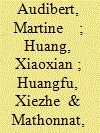

|
|
|
|
|
| Summary/Abstract |
Since the early 2000s, the Chinese government has undertaken a series of reforms in the health sector. Among these, the three most important have been concerned with medical insurance, hospital administration, and pharmaceutical policies. The aims of these reforms were to extend health insurance coverage, to increase the activities and the efficiency of the health establishments, and to improve patient care. This article focuses on two components of these reforms: the development of health insurance in rural areas and the policy on essential medicines in conjunction with hospital reforms. Our longstanding co-operation with a research team from Weifang University and with the Weifang Health Bureau allowed us to follow these reforms and collect data (primary source) from a sample of township hospitals from Weifang Prefecture. Those data allowed us to study their effects on health facilities' level of activity and efficiency. This article provides an overview of studies we carried out on these issues over the period from 2000 to 2012. Our analyses were mainly based on non-parametric models (Data Envelopment Analysis, Malmquist Index, and partial frontiers) and impact analyses, coupled with interviews with hospital staff and medical authorities. Results show that the development of health insurance in rural areas had a positive effect in greatly increasing the activities of the hospitals covered by our study. On the other hand, it did not have a positive influence on their efficiency, which declined in the period concerned. This result is to be explained by the fact that, even though staff activity increased, it remained low, since the observed increase in activity was not sufficient to make up for the parallel increase in staff numbers. Similarly, reforms in the hospital and pharmaceutical sectors had no effect on the township hospitals of our survey. In fact, in order to compensate for the observed reduction of hospital resources following the introduction of the reforms, on the one hand the government increased the subsidies allocated to township hospitals, and on the other hand the hospitals strongly innovated in sophisticated and expensive care, to the benefit of a relatively small number of patients. Therefore, there were some very positive steps forward, but they still call for a more nuanced assessment of the effects of the reforms.
|
|
|
|
|
|
|
|
|
|
|
|
|
|
|
|
| 11 |
ID:
145581
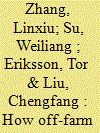

|
|
|
|
|
| Summary/Abstract |
Using three-wave survey data for four villages of Jiangsu Province in China, the present paper examines whether and to what extent off-farm employment affects the technical efficiency of agricultural production. The level of technical efficiency is measured using a stochastic frontier production function approach. Based on estimation results from instrumental variable panel quantile regressions we find that there is a positive significant effect of off-farm employment on the level of farm technical efficiency. We also find that fragmentation of farmland is a barrier to the improvement of technical efficiency. In addition, we find a downward trend in the level of agricultural technical efficiency among our sample. Therefore, the Chinese Government should stimulate agricultural mechanization and the development of farming techniques to improve technical efficiency in the context of increasing off-farm employment.
|
|
|
|
|
|
|
|
|
|
|
|
|
|
|
|
| 12 |
ID:
111146


|
|
|
| 13 |
ID:
110391


|
|
|
|
|
| Publication |
2011.
|
| Summary/Abstract |
This study evaluates the performance of 29 Electricity Distribution Divisions (EDDs) of an Indian state - Uttarakhand - deploying Input oriented Data Envelopment Analysis (DEA). The results indicate that the performance of several EDDs is sub-optimal, suggesting the potential for cost reductions and possible reduction in employees number. In the DEA method more than one unit are identified as efficient. Therefore, this study suggests a method for ranking the efficient units by their importance as benchmarks for the inefficient units through benchmark share measure. The bigger the benchmark share, the more important an efficient division is in benchmarking for inefficient ones. Result reveals that plain area divisions are relatively efficient and have higher potential to influence the performance of inefficient EDDs. This study is envisaged to be instrumental to policy makers and managers to increase the operational efficiency of inefficient EDDs and thereby increase the competitiveness in the face of restructuring and liberalization of Indian electricity sector.
|
|
|
|
|
|
|
|
|
|
|
|
|
|
|
|
| 14 |
ID:
096232
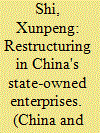

|
|
|
|
|
| Publication |
2010.
|
| Summary/Abstract |
Using firm-level data for China's state-owned coal mines, this paper examines the impact of privatization, corporatization and debt restructuring of state-owned enterprises on technical efficiency. A stochastic frontier production method is applied to a panel dataset from 2000 to 2007. The simultaneous study of these three measures makes it possible to study individual effects more precisely than otherwise. The study shows that the three reform initiatives are all able to improve technical efficiency in state-owned coal mines. The finding of a significant efficiency improvement from relinquishing state ownership provides an alternative to privatization. The study of debt restructuring and technical efficiency has not been documented in the published literature.
|
|
|
|
|
|
|
|
|
|
|
|
|
|
|
|
| 15 |
ID:
163523
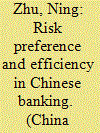

|
|
|
|
|
| Summary/Abstract |
This paper aims to measure banking efficiency by considering risk preferences in 49 Chinese commercial banks during the period of 2004–2012. It adopts a method which allows for endogenous classification of three risk preferences, namely the conservative, moderate and aggressive risk modes, by changing direction vectors. Banking efficiency is measured on the basis of optimal risk preference. The findings show that the moderate risk preference is the most appropriate strategy to achieve technical efficiency in the Chinese banking sector. However, the aggressive risk preference involving low risk costs, compulsory credit spreads and scale expansion played a critical role in promoting the development of Chinese banking sector, but its effect decreased rapidly. The findings also imply that the average technical efficiency scores of joint stock commercial banks and city commercial banks were higher than those of state-owned commercial banks under the optimal risk preference, and that the measured efficiency mainly shows a trend of improvement over time.
|
|
|
|
|
|
|
|
|
|
|
|
|
|
|
|
| 16 |
ID:
105280
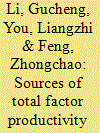

|
|
|
|
|
| Publication |
2011.
|
| Summary/Abstract |
Provincial panel data from the agricultural sector and stochastic frontier production function model were employed to study the total factor productivity (TFP) growth since the 1980s in China. We decomposed the TFP growth into technological progress and technical efficiency changes (efficiency gains) as well as the aggregate agricultural TFP growth into crop-specific subsector's TFP growths. We found that Chinese agriculture experienced significant productivity growth in the last few decades, although the growth rates vary considerably among the subsectors. During this period, the source of productivity growth comes from either technological progress or efficiency gains, not from both of them simultaneously. Particularly since the 1990s, Chinese agriculture experienced a great technological progress and yet a considerable efficiency loss. The differences among sources of productivity growth and among subsectors call for distinct policy responses.
|
|
|
|
|
|
|
|
|
|
|
|
|
|
|
|
| 17 |
ID:
161820


|
|
|
|
|
| Summary/Abstract |
Official data are criticized for over-reported agricultural labour statistics. We derive an alternative series of labour participated in agriculture with the information of production cost and revenue. Using parametric stochastic frontier approach, labour requirement functions are estimated for 30 farm and animal husbandry products in rural China. The estimated required amount of labour is compared with our newly-derived observed agricultural labour to obtain the surplus labour. This surplus ranges from 18% to 12% of agricultural labour between 2001 and 2013. Our results reveal that China was relatively successful in reducing redundant labour in rice production. Equally important, the trends of our estimated surplus place China in the second stage of transition under the Lewis-Fei-Ranis framework, moving in the direction of full commercialization or the so-called Lewis turning point.
|
|
|
|
|
|
|
|
|
|
|
|
|
|
|
|
| 18 |
ID:
119817


|
|
|
|
|
| Publication |
2013.
|
| Summary/Abstract |
In the present study, Data Envelopment Analysis is used to determine the Technical Efficiency index of EU-15 countries from 1980 to 2008, using cross-country comparison. Technical Efficiency index represents the capacity of an economy to produce a higher level of Gross Domestic Product for a given level of total energy input. The level of the Technical Efficiency index is determined from the energy mix (fossil fuels, non-fossil fuels, nuclear energy) of each country and depends on the maximization level of the production of the Gross Domestic Product of the economic system, without waste of energy resources. The current study is applied in the case of the EU15 countries. Its scope is to highlight the differentiations of country classifications before and after the integration of nuclear energy in the energy mix of each country. The main result is that the integration of nuclear energy as an additional input in the energy mixture affects negatively the Technical Efficiency of countries. Also, when an economy achieves a decrease of the energy consumption produced from fossil fuels, and a better exploitation of renewable energy sources, clearly improves its capacity to produce more output with the given levels of inputs.
|
|
|
|
|
|
|
|
|
|
|
|
|
|
|
|
| 19 |
ID:
084464
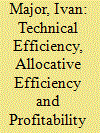

|
|
|
|
|
| Publication |
2008.
|
| Summary/Abstract |
By applying a simple model of frontier production functions, this article shows that Hungarian small and medium-sized enterprises (SMEs) produce far below their feasible level, given their input endowment. The SMEs' under-production is rooted in the allocative inefficiency of small and medium-sized firms: they use labour in excess while they lack a sufficient level of capital assets. As a consequence of large inefficiencies, Hungarian SMEs improve profitability by scaling down production rather than by expansion.
|
|
|
|
|
|
|
|
|
|
|
|
|
|
|
|
| 20 |
ID:
191147


|
|
|
|
|
| Summary/Abstract |
This paper improves the estimation of firm-level total factor productivity (TFP) by considering energy use and including small- and medium-sized enterprises using data from the Chinese National Tax Survey Database (2008–2011). It analyzes the production efficiency of Chinese manufacturing firms using the improved TFP data and finds that (i) the TFP data frequently used in previous studies overestimated firms' real production efficiency; (ii) the TFP of manufacturing firms decreased from 2008 to 2011 due to declines in both technical efficiency and allocation efficiency; (iii) the lower capacity utilization of production factors led to lower technical efficiency; and (iv) allocation efficiency decreased more in provinces and industries with higher shares of state-owned enterprises. The findings have policy implications for enhancing growth potential in the long run.
|
|
|
|
|
|
|
|
|
|
|
|
|
|
|
|
|
|
|
|
|